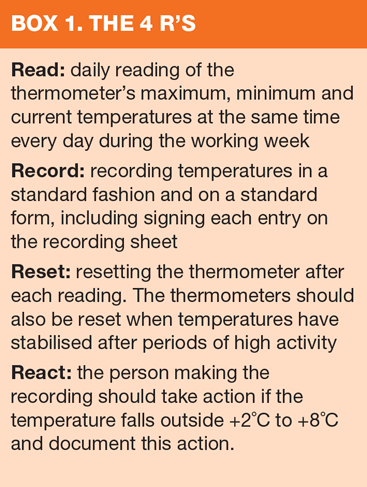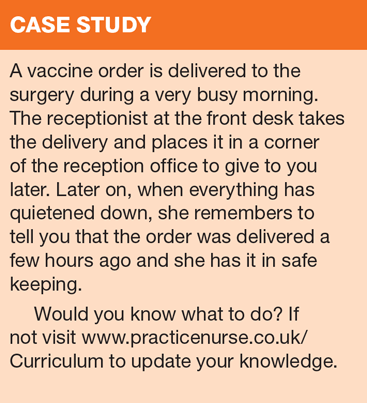Vaccine storage and the cold chain: What every practice nurse needs to know
When it comes to vaccine storage and the cold chain, it seems that all too often, we are not getting it right. And even if you think you know your stuff, it is worth refreshing your knowledge with this Practice Nurse guide
When you buy a sandwich in a supermarket, you have confidence that it was prepared in hygienic and temperature-controlled conditions, chilled promptly, transported in a refrigerated vehicle, and displayed in a chill cabinet. You don’t expect it to have been sitting around in a warm environment, or for the storage temperature to have fluctuated, so you don’t worry whether or not it may have deteriorated. If supermarkets can take that much care over a simple sandwich, how much more careful should we be about vaccines?
Yet the Care Quality Commission (CQC) has repeatedly found that practices don’t have a named person with responsibility for vaccines, nor a written policy or protocol for the management of vaccines, which should include ordering, storage and spoilage. The CQC commonly finds problems with vaccine fridges and monitoring, and a lack of knowledge of what to do if the vaccine fridge is compromised.
The NMC code of conduct states: ‘As a professional, you are personally accountable for actions and omissions in your practice’.1 Therefore, any nurse administering vaccines should be aware of the cold chain, how to store vaccines, maintenance of the refrigerator temperature and the actions to take if there is a break in the cold chain.
WHAT IS THE ‘COLD CHAIN’?
The ‘cold chain’ is the term used to describe the handling and storage of temperature-sensitive goods from manufacture through distribution to storage and ‘sale’. In general practice, the goods in question are vaccines, and their temperature needs to be controlled from the moment they are manufactured, right through to their administration to the patient. Full details can be found online in Public Health England’s Green Book,2 which is the definitive source of information on immunisation and vaccines.
WHY IS IT IMPORTANT?
All vaccines need to be kept at the manufacturer’s recommended temperature range of between 2°C and 8°C, and protected from light at all times, until they are given to a patient. These cold temperature conditions are vital for the efficacy and potency of the vaccine, which cannot be guaranteed if the vaccine is frozen or kept outside these temperatures. If you bought a sandwich from a supermarket you would expect that similar conditions would have been followed so that you do not get food poisoning from eating the sandwich, so keeping vaccines at the right temperature should be as important, if not more so, in the prevention of disease.
HOW SHOULD VACCINES BE STORED?
Vaccines must be stored in a dedicated specialist vaccine refrigerator in their original packaging to retain their batch numbers and expiry dates. No food, drink or clinical specimens should be kept in the fridge alongside the vaccines.
The vaccines should be kept away from the back and sides of the refrigerator to allow air to circulate around them, and they should not be stored on shelves in the door.
Stock rotation is important: vaccines with short expiry dates can be marked in red, and new stock should be placed at the back, behind earlier stock. It helps to group the childhood vaccines according to the childhood immunisation schedule, and to have travel vaccines grouped together on another shelf if there is room to do this. Some vaccine packaging looks very similar and it is useful to have a colour poster of the different vaccines near the refrigerator. Expired, out of date vaccines must not be used but disposed of carefully.
Specialist refrigerators will have glass doors, be lockable and have a maximum/minimum temperature gauge on the outside so that it can be easily read on a daily basis without having to open the door. All vaccines are Prescription Only Medicines (POMs), and therefore must be kept under locked conditions.
The electricity supply to the refrigerator should be via a switchless socket – or the plug should be clearly labelled ‘do not turn off’ and some sticky tape put across the switch – to prevent the fridge from being switched off inadvertently.
If vaccines, e.g. flu vaccines, are taken away from the premises, for instance to be given at a nursing home, then they should be carried in a validated medical-grade cool box and returned to the practice refrigerator as soon as possible. Make sure that any ice packs are not in contact with the vaccines.
RESPONSIBILITY FOR VACCINE STORAGE
A practice protocol should be developed to cover all aspects of vaccine storage and maintenance of the cold chain.3 There needs to be a named, trained person or persons (preferably one from the nursing team and one from management to cover annual leave or sickness), who is responsible for ordering, receipt and care of vaccines and for maintaining the optimum conditions for the vaccines. It is good practice to keep no more than two to four weeks’ supply of vaccines at any time, as this is usually adequate for routine clinics. Best practice is to order small quantities on a regular, scheduled basis.
RECORD KEEPING
When the vaccines are delivered to the practice, whoever takes them in should immediately take them to the refrigerator, check that the packaging is intact and either put them straight in as they are or contact the designated person to unpack them. The invoice should then be signed with the time received and a note that the packaging was intact.
The Green Book recommends that a log is kept of maintenance, cleaning and electrical testing as well as the daily temperature reading. A sample log can be found in Chapter 3 of the Green Book,4 which also provides a useful reminder, the ‘4 R’s’ (Box 1).
WHAT TO DO IF THE COLD CHAIN FAILS
The practice protocol needs to include the actions to be taken by the designated person (or persons) if a failure or disruption occurs but the responsibility for alerting someone to a failure should be everyone’s responsibility. Any vaccine that has not been stored at the temperature recommended by the manufacturer is no longer a licensed product and should not be used.
Actions in the protocol should include:
- Keeping the refrigerator door closed to maintain the temperature until an action plan has been formed
- Assessing the cause of the failure and establishing how long the power has been disrupted
- Notifying the practice manager, obtaining advice from the local immunisation co-ordinator and the vaccine manufacturers and reporting the incident to the local incident reporting scheme
- Recording all details of the incident
- Quarantining the affected vaccines but maintaining the cold chain if possible
- Safe disposal of unusable vaccines whether damaged or out of date
It is recommended that refrigerator records should be kept for 1 year and vaccine expiry dates and batch numbers for 10 years, so that the history is known if there are any problems. The Consumer Protection Act 1987 allows patients to claim up to 10 years after a medicine has been administered (in paediatrics up to 28 years – maturity plus 10 yrs).5
Vaccines are very expensive – they cost the NHS approximately £200 million a year6 – and should not be wasted, so care of them is vital.
THE GIVING OF VACCINES
Most vaccines are recommended to be given at room temperature, and they soon warm up when removed from the refrigerator. Best practice is to remove some for a clinic, to save opening and closing the refrigerator door too often, but to put those left back in the refrigerator as soon as the clinic has finished. It is tempting during the flu season to leave some flu vaccines in doctors’ rooms so that they can be given opportunistically; however, this may lead to the vaccines being left out longer than recommended so that they lose their efficacy and will be wasted. This is not good practice. The loss of only one dose of Pediacel/Infanrix vaccine a month in each general practice would cost an estimated £4 million a year!7
The vaccines must be shaken before use and inspected visually before administration to make sure that they are mixed properly and the unit is intact. Any vaccine that has to be reconstituted should be mixed as needed and not prepared in advance of the patient being in the room. If this happens then the vaccine must be used as soon as possible, usually within 1–4 hours (check the Summary of Product Characteristics [SPC] for individual vaccines) or discarded at the end of the clinic.
CHECKLIST FOR ACTION
- Check if your practice has a cold chain policy
- Find out if there is a named person for carrying out the policy and discuss the policy with them. If there isn’t a named person, talk to the practice manager about it
- Check what happens to the vaccines when they are delivered to the practice and who checks them in
- Review checking and recording of daily fridge temperatures: who does this?
- Make sure vaccines are not overcrowded in the fridge and rearrange them if they are
- Check vaccine expiry dates
- Check what to do if you find the fridge temperature is above or below the recommended temperature range
CONCLUSION
All members of the primary care team should be aware of the importance of good vaccine management. The responsibility for correct vaccine storage is everyone’s responsibility not just that of the named individual. If you notice the fridge is turned off or the temperature gauge is reading high or low, tell someone immediately before the vaccines are wasted. If you are the nurse administering the vaccines then it is your responsibility to see that the cold chain has been maintained.
REFERENCES
1. http://www.nmc-uk.org/Publications/Standards/The-code/Introduction/
2. https://www.gov.uk/government/publications/storage-distribution-and-disposal-of-vaccines-the-green-book-chapter-3
3. gov.uk/en/Publicationsand statistics/Publications/PublicationsPolicyAndGuidance/DH_120010
4. The Department of Health Immunisation against infectious disease – Storage, distribution and disposal of vaccines: the Green Book, chapter 3: https://www.gov.uk/government/uploads/system/uploads/attachment_data/file/223753/Green_Book_Chapter_3_v3_0W.pdf
5. NHS East of England Senior Pharmacy Managers Network 2008; Department of Health 2009
6. http://www.cqc.org.uk/content/gp-mythbuster-17-vaccine-storage-and-fridges-gp-practices
7. Health Protection England: https://www.gov.uk/government/uploads/system/uploads/attachment_data/file/300304/Protocol_for_ordering__storing_and_handling_vaccines_March_2014.pdf
Related articles
View all Articles


